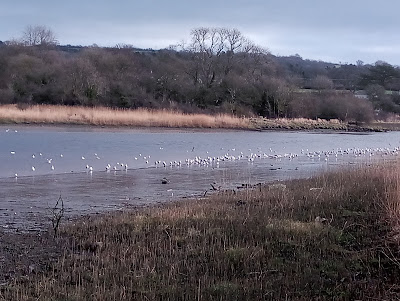Mid Feb... Iceland Gull and Butterfly eggs
The season is moving on, some species are leaving, some are now in song ...
The falling tide as seen from the main path, the Gulls favour the river through the reserve, rather than feeling the blast of the westerly wind in the open estuary. 200m down river, the adult Iceland Gull was opposite Curlew hide at 930 yesterday ..
The scene from the hide, and the Iceland Gull is there...
Further up river, 5-6 Little Egrets in the horse paddocks before the Sawmill, interestingly these don't appear to be in breeding plumage unlike those around the reserve or in the estuary..
The Barnacle Geese haven't settled down yet, over the last few days the whole flock, c 130 are either on Cardigan Island where most will nest, or grazing in the cliff top fields.
A short look at the sea proved worthwhile this morning, with 2 Red-throated Divers, 2 Kittiwakes and a single male Common Scoter all flying west past Cemaes Head.
Ducks are disappearing fast, most obvious are the Wigeon, down to 87 birds today. The Golden Plover are missing and we have only seen a maximum of c 200 Lapwing. The Redshank -50, Dunlin-60/80, and Ringed Plover -18 are all still stable.
A sign today of passerine movement with a couple of flocks of Meadow Pipits on the edge of Poppit Dunes
 |
| Poppit dunes and scrub |
This area of dunes to the west of the Lifeboat Station is particularly good for finding Pipits. There is usually a Stonechat pair around often feeding on the roof of the Lifeboat Station. Black Redstarts have turned up on the roofs in this area but not so far this winter.
 |
| Black Redstart Poppit 23rd Dec 2019 |
More in a future blog about Brown Hairstreak Butterflies but just a note from the Butterfly recorder for Ceredigion, Paul Taylor with some exciting news.
 |
| Brown Hairstreak Egg |
Paul visited the Naturewise Community Forest Garden near Cardigan Police Station on Parc Teifi to undertake a survey with some of the volunteers, for Brown Hairstreak eggs.
Paul writes, "The butterfly itself is quite elusive and restricted to certain areas along the Teifi valley. The butterfly flies between end of August until the beginning of October and spends most of its time in the high tree canopy, primarily around Oak and Ash when it will feed on the sugar solution secreted by Aphids. The eggs are laid on Blackthorn bushes - mainly on new growth. Within a few minutes of starting the survey, 1 egg had been found, and shortly after another 3 found by one of the volunteers. In all, by the end of our short session, we had found 15 eggs, with still more of the site still to be surveyed. This has been one of the most rewarding survey I have taken part in, as in so many cases this particularly butterfly has been lost in an area, so very rewarding to find so many eggs in such a short space of time, and one of the few remaining strongholds in Ceredigion."
Highlights from the Teifi timeline until mid March when we return from The Gambia. On our return we will resume our Teifi sightings, summaries and history - - but some of the highlights over recent years from mid February to mid March include, Iceland, Glaucous, Ring-billed, Little and yellow-legged Gulls. Cattle Egret, Bitterns, and a Smew amongst an increasing variety of commoner ducks. Water Pipit, Firecrests and the first summer migrants arrive with Sand Martins in March - the earliest recorded on the 1st. Maybe the highlight for many was a Great Grey Shrike at Kingfisher Pond for several weeks in 2010... and a little further back in history the Mallard Pond was created by a JCB on Feb 8th 2008 !! A write up on The Mallard Pond in Feb 2023 ...
Rich D and Wendy J

